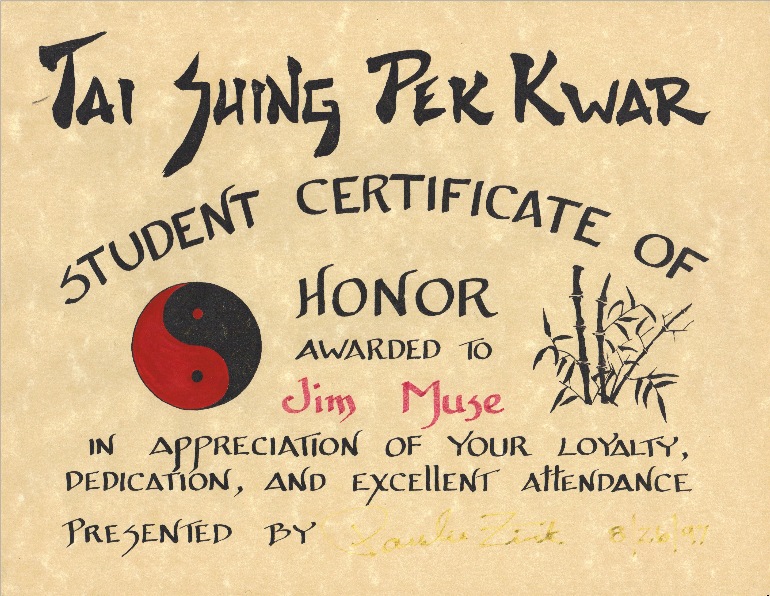MONKEY KUNG - FU HISTORY
TAI SHING PEK KWAR MONKEY KUNG - FU
Tai Shing Pek Kwar Monkey Kung Fu is a rare martial art. It is challenging to find teachers who teach this art, but luckily you have found one. United School of Martial Arts Kung Fu Academy teaches Tai Shing Pek Kwar Monkey Kung Fu as part of its curriculum. Call the school to check the availability of classes in this rare and beautiful martial art.
Click Here to read Master Paulie Zink's Open Letter
HISTORY OF TAI SHING PEK KWAR MONKEY KUNG FU
by Master Paulie Zink
Tai Shing Pek Kwar is actually comprised of three separate kung fu arts: Monkey, Pek Kwar, and Tei Tong. Tei Tong translates to “Grand Earth”. Pek Kwar has no direct English equivalent. It roughly translates to “chopping hand” or “ax hand”. Tai Shing translates to “Great Sage”. The title Great Sage refers to the magical and mischievous “Monkey King”, Sun Wu Kung, a mythical monkey being from the Chinese Buddhist epic legend “Journey to the West”.
PEK KWAR
The style of Pek Kwar was developed by a master of northern Chinese kung fu named Ma Chi Ho. Prompted by a cryptic statement made by a Taoist priest in passing, Master Ma Chi Ho taught himself to direct his chi through his arms and legs. By filling his limps with energy he created a protective aura around them. He learned to use his arms and legs in swinging and chopping motions similar to the movements of someone wielding an ax. Pek Kwar uses both circular and linear strikes and blocks, and requires flexibility for high kicks.
Master Ma Chi Ho’s protégé was Ken Ming Kwai, who transmitted the art to his son, Ken Yung Kwai, who in turn transmitted the art to his son, Ken Tak Hoi.
TAI SHING (Monkey)
The Monkey style of Kung Fu originated in the early part of the twentieth century. It was developed by a master of Tei Tong kung fu named Kou Sze. Tei Tong kung fu consists of ground rolling techniques and kicking and striking from low positions. Master Kou Sze was a fierce fighter. One day he killed an evil man in his village. Consequently Master Kou Sze was sentenced to eight years of solitary confinement in prison. From his prison cell window he could observe a troupe of monkeys. Over the years Master Kou Sze closely studied the monkeys’ movements and behaviors. From these observations he created an entire kung fu system based on the physical, mental, and energetic characteristics of monkeys. There are five separate styles of monkeys contained within the art. These are the Tall Monkey, the Stone Monkey, the Lost Monkey, the Wooden Monkey, and the Drunken Monkey. Each style expresses a different monkey personality type and form of movement.
Master Kou Sze was friends with Pek Kwar Master Ken Ming Kwai. The Ken family operated a successful bodyguard service in China. After Master Kou Sze was released form prison, Ken Ming Kwai sent his grandson Ken Tak Hoi to study with him. Ken Tak Hoi served as a bodyguard in the royal palace at a young age, and he soon opened his own bodyguard service. Ken Tak Hoi became the protégé of Master Kou Sze and studied with him for ten years. Ken Tak Hoi was a master swordsman as well as a great chi kung master. He combined the three arts of Monkey, Pek Kwar, and Tei Tong into a style he called Tai Shing Pek Kwar.
Master Ken Tak Hoi later moved to Hong Kong and opened a kung fu school with his protégé Cho Chi Fung. However Cho Chi Fung left the school after a few years. While he lived in Hong Kong, Cho Chi Fung transmitted the art of Tai Shing Pek Kwar to his nephew Cho Chat Ling.
When Grandmaster Ken Tak Hoi died, one of his senior students named Chan Sau Chung took over the school. Under Master Chan’s leadership the school produced many famous champion kung fu fighters.
Cho Chat Ling moved to the U.S. in the late 1970’s where he met Paulie Zink and eventually trained him as his sole protégé.
The Style of Tai Shing Pek Kwar transmitted to Master Zink is comprised of over a total of 50 empty hand and weapons forms. The arts of Pek Kwar and Monkey each contain forms for all the classic Chinese weapons including the double swords, staff, spear, knife, the two and the three section staffs, straight sword, broad sword, erh mei daggers, and others.
Below is the Student Certificate of Honor presented
to our teacher GRANDMASTER JIM MUSE FURTADO by Master Zink
